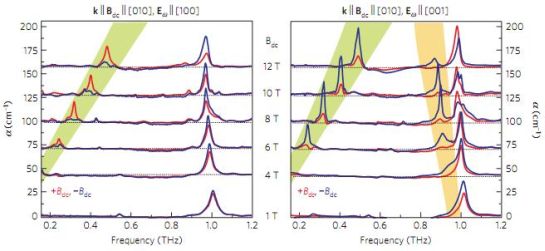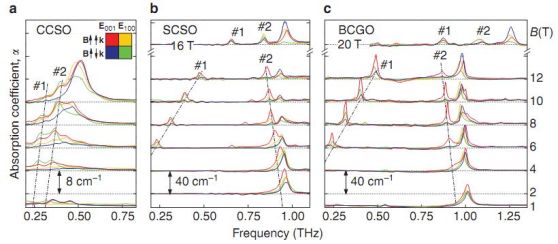|
|
BMe Research Grant |
|
BME Doctoral School of Physics
Department of Physics/Institute of Physics
Supervisor: Dr. István Kézsmárki
Novel optical phenomena in multiferroic materials
Introducing the research area
In the course of my PhD research, I study the low energy optical properties of multiferroic crystals. The coupling of the electric and magnetic degrees of freedom in these materials leads to novel optical phenomena like the directional dichroism.

Brief introduction of the research place
The research area of the Magneto-optical Spectroscopy Laboratory of the BME spans from the development of a malaria diagnostic device to fundamental solid state physics. These topics are connected by the common experimental methodology: our group investigates the optical properties of magnetic crystals taking advantage of the unique instrumentation developed in our laboratory. Besides that we have established several international collaborations in the field of multiferroics including laboratories in Tallinn, Augsburg and Nijmegen.
History and context of the research
Multiferroics, materials with simultaneous magnetic and ferroelectric order, offer a promising area for both fundamental research and technological applications [1,2]. Via the magneto-electric cross coupling, the magnetization of these materials can be manipulated by external electric fields, while electric polarization can be controlled by magnetic fields. This effect can be utilized in the read-and-write heads of hard disks, allowing for higher data density by a more direct connection between the electronics and data stored magnetically, moreover, the writing operation could be performed at a low level of power consumption.
Due to magneto-electric coupling, the strength of low-energy magnetic excitations, the spin waves (magnons) can depend on the propagation direction of the exciting light beam [3,A]. Therefore, such media can differentiate between counter-propagating beams. They can absorb the two beams to different extent. Although this phenomenon, called directional dichroism, was already predicted [4] in 1963 for systems simultaneously breaking time reversal and spatial inversion symmetries, the experimental observations of directional dichroism was first reported in the late ‘90s and it has generally been recognized as a weak effect [5,6].
The proper separation of light source from the optical cables used in high speed data transfer is essential, which could be realized by optical rectification without loss on the signal intensity. A possible realization is proposed based on the latest experiments on multiferroics, which reported the relative directional absorption differences close to unity [7,8].
 In this case the medium transmits light only in one direction, and the opposite not. However, the typical ordering temperature of known
multiferroic crystals fall in the order of a few Kelvin, which is a
strong drawback concerning their applications.
In this case the medium transmits light only in one direction, and the opposite not. However, the typical ordering temperature of known
multiferroic crystals fall in the order of a few Kelvin, which is a
strong drawback concerning their applications.
The research goal, open questions
The direction-dependent light propagation contradicts both our everyday experience and the principle of reciprocity, generally applied in geometrical optics. Thus, the investigation of this novel phenomenon can substantially extend the scope of optics. Moreover, combining conventional optical anisotropy effects, such as linear or circular dichroism, with directional dichroism could lead to four different indices of refraction for light propagation along a given axis, according to the four combinations of orthogonal light polarization states and opposite propagation directions. Multiferroic crystals offer an ideal playground for studying this new effect, which can be termed as quadrochroism.
According to Neumann’s principle, directional dichroism is only possible along axes where the opposite propagation directions are not connected by symmetries in magnetic crystal. This makes directional dichroism spectroscopy a powerful tool in the determination of the symmetry of crystals where the exact magnetic order is debated. And vice versa, based on the magnetic symmetry of the material, the presence or absence of directional dichroism can also be predicted.
Directional dichroism is generated by dynamic magneto-electric coupling which is connected to the static magneto-electric effect potentially utilized in future data storage applications. The linear response theory may provide a connection between the two phenomena, i.e. one could specify how the optical directional dichroism spectrum influences the electric response to a static magnetic field in these materials.
The magnetic field and temperature dependence of the excitation frequencies of magnon modes provide essential information about the exchange interactions and magnetic anisotropies governing the behavior of spin systems. The ferroelectric polarization of multiferroics is created by the relativistic spin-orbit interaction, a more in-depth understanding of which can also expected from the investigation of directional dichroism spectrum.
Methods - Far-infrared spectroscopy in high magnetic fields
The low energy magnetic excitations of the multiferroic crystals studied in the course of my PhD research can be excited by far-infrared light. The intensity of commercially available light sources in this wavelength region is low, especially when compared to the thermal background radiation. Therefore, we had to use the whole far infrared intensity of the source during the measurement.
Nevertheless, we are still able to perform spectral measurements thanks to the Fourier-transform technique. In the interferometer, the light beam of the source is split by a beamsplitter. The two beams travel different distances, thus when reunited they produce interference. The optical properties of the sample are investigated with the united beam. The optical path length difference of the two beams is smoothly changed by a mirror moving at constant velocity, thus the condition of constructive interference is met for different wavelengths at different times. The spectral response of the sample can be calculated by the Fourier-transform of time-dependent signal.
In the case of a Martin-Puplett interferometer, a polarizing wire-grid beam splitter is applied, with the periodicity of the grid corresponding to the wavelength of light. The grid reflects the light with polarization parallel to the wires and transmits the perpendicular polarization. This allows a more effective division of the intensity in two equal parts as compared to the dielectric polarization independent beam splitters applied in Michelson-interferometers. The light source is usually a mercury-arc lamp in a quartz housing, while a low temperature bolometer, i.e. a device capable of measuring the heating power of light, is applied as detector.

Since the crystals I studied show multiferroic order only at temperatures below a few kelvins, a cryostat cooled by liquid helium was applied. A magnetic field of several tesla is required for the experiments to investigate the magnetic field dependence of the magnon excitations. Usually, a superconducting magnet is applied, though the critical magnetic field of superconductors limits their application below 20 T.
For my experiments, I mostly used the SPS200 Martin-Puplett interferometer of TeslaFIR laboratory at the National Institute of Chemical Physics and Biophysics in Tallinn. This spectrometer is coupled to a superconducting magnet of 17 T. For the optical studies in higher magnetic fields, I used the 33 T resistive magnet of the High Field Magnet Laboratory in Nijmegen. This magnet is connected to a Bruker113 Michelson-interferometer.
Results
In the magnon excitation spectrum of the easy plane antiferromagnet Ba2CoGe2O7 strong magneto-chiral dichroism can be observed. This directional dichroism effect arises in chiral systems, i.e. systems without mirror plane symmetries, when exposed to magnetic field. The absorption of light is different for light propagation along or opposite to the direction of the magnetic field. The significance of our result [A] highlighted also on the cover of Nature Physics, can be attributed to both the strength of directional effect and the origin of chirality. The arrangement of atoms in Ba2CoGe2O7 is not chiral, but the antiferromagnetic ordering of spins breaks the mirror plane symmetries of the crystal, making the whole system chiral.
|
|
Directional dichroism arising in the magnon absorption spectrum of Ba2CoGe2O7. Red and blue curves show the absorption for light propagation parallel and antiparallel to the direction of the magnetic field for the two relevant polarizations [A]. |
I investigated the magnetic field dependence of the spin excitation spectrum of Ba2CoGe2O7 in high magnetic fields up to 33 T. Based on these experimental results, the coupling constants of an effective spin model were determined and a multi-boson theory was developed by Dr. Karlo Penc and Dr. Judit Romhányi [B] to describe the behavior of magnon modes.
Besides Ba2CoGe2O7, I also have found strong directional dichroism in the far infrared excitation spectrum of Ca2CoSi2O7 and Sr2CoSi2O7 crystals, belonging to the same melilite family. Since absorption depends both on the polarization state of light and on the direction of propagation, each of these materials has four different indices of refraction for one light propagation axis, realizing the optical quadrochroism effect [C].
|
|
Optical quadrochroism in the spin excitations of multiferroic mellite crystals. Absorption coefficients corresponding to different combinations of the two opposite propagation directions and the two orthogonal polarization states are plotted with different colors [C]. |
By analysing the magnetic point groups describing the symmetries of magnetic crystals, I could determine the cases where directional dichroism is allowed by symmetry for light beams propagating along crystallographic axes. Beyond the already known examples such as magneto-chiral dichroism I have found other possibilities as well [D].
Besides their optical excitations, the static behavior of melilite crystals is also interesting. The magnetization measurements in high magnetic fields together with the spin polarized neutron diffraction results of Dr. Bálint Náfrádi’s group allowed us clarify the ground state orientation and the saturation length of magnetic moments in Ba2CoGe2O7 [E].
Using statistical physical approach, I have found that static magneto-electric coupling can be calculated by summing the low energy absorption difference of opposite light propagation directions. The results of static magneto-electric measurements can be found in the literature [9] and the far-infrared directional dichroism spectra of melilite materials confirm this magneto-electric sum rule [F].
Expected impact and further research
The strong directional dichroism found in the low energy excitations of multiferroic crystals together with the magneto-electric sum rule directly connecting this phenomenon to the static magneto-electric effect can give a new momentum to the optical research of these materials.
By applying the sum rule to the results of high temperature static measurements on melilite crystal family [10,11], the existence of directional dichroism in high magnetic fields at temperatures orders of magnitudes higher than the magnetic ordering temperature can be predicted. This effect can bring future applications of optical rectification closer.
Based on the magneto-electric sum rule and the symmetry analysis, the presence of directional dichroism is highly possible in a wide range of multiferroics, thus their optical investigation seems very attractive. At present, I investigate the magnon modes of Ni3TeO6 crystal, which recently attracted much attention due to its electrically controllable magnetic phase transition [12].
In the topic of my PhD research, I contributed to six publications, which appeared in the Nature Physics, Nature Communications, Physical Review Letters and Physical Review B journals. 37 citations on these papers over the past two years indicates the scientific attention in this field.
Publications, references, links
Publications
- S. Bordács, I. Kézsmárki, D. Szaller, L. Demkó, N. Kida, H. Murakawa, Y. Onose, R. Shimano, T. Rõõm, U. Nagel, S. Miyahara, N. Furukawa and Y. Tokura: Chirality of matter shows up via spin excitations, Nat. Phys. 8 734738 (2012)
- K. Penc, J. Romhányi, T. Rõõm, U. Nagel, Á. Antal, T. Fehér, A. Jánossy, H. Engelkamp, H. Murakawa, Y. Tokura, D. Szaller, S. Bordács, and I. Kézsmárki: Spin-Stretching Modes in Anisotropic Magnets: Spin-Wave Excitations in the Multiferroic Ba2CoGe2O7, Phys. Rev. Lett. 108 257203 (2012)
- I. Kézsmárki, D. Szaller, S. Bordács, V. Kocsis, Y. Tokunaga, Y. Taguchi, H. Murakawa, Y. Tokura, H. Engelkamp, T. Rõõm, and U. Nagel: One-way transparency of four-coloured spin-wave excitations in multiferroic materials, Nat. Commun. 5 3203 (2014)
- D. Szaller, S. Bordács, I. Kézsmárki: Symmetry Conditions for Non-reciprocal Light Propagation in Magnetic Crystals, Phys. Rev. B 87 014421 (2013)
- V. Hutanu, A. P. Sazonov, M. Meven, G. Roth, A. Gukasov, H. Murakawa, Y. Tokura, D. Szaller, S. Bordács, I. Kézsmárki, V. K. Guduru, L. C. J. M. Peters, U. Zeitler, J. Romhányi, and B. Náfrádi: Evolution of two-dimensional antiferromagnetism with temperature and magnetic field in multiferroic Ba2CoGe2O7, Phys. Rev. B 89 064403 (2014)
- D. Szaller, S. Bordács, V. Kocsis, T. Rõõm, U. Nagel, and I. Kézsmárki: Effect of spin excitations with simultaneous magnetic- and electric-dipole character on the static magnetoelectric properties of multiferroic materials, Phys. Rev. B 89 184419 (2014)
Links
Optical properties of multiferroic crystals
References
- M. Fiebig: Revival of the magnetoelectric effect, J. Phys. D: Appl. Phys. 38 R123 (2005)
- K. F. Wang, J.-M. Liu and Z.F. Ren: Multiferroicity: the coupling between magnetic and polarization orders, Adv. Phys. 58 321 (2009)
- I. Kézsmárki, N. Kida, H. Murakawa, S. Bordács, Y. Onose and Y. Tokura: Enhanced Directional Dichroism of Terahertz Light in Resonance with Magnetic Excitations of the Multiferroic Ba2CoGe2O7 Oxide Compound, Phys. Rev. Lett. 106 057403 (2011)
- W. F. Brown, S. Shtrikman, and D. Treves: Possibility of Visual Observation of Antiferromagnetic Domains, J. Appl. Phys. 34 1233 (1963)
- G. L. J. A. Rikken and E. Raupach: Pure and cascaded magnetochiral anisotropy in optical absorption, Phys. Rev. E 58 5081-5084 (1998)
- G. L. J.A. Rikken, C. Strohm, and P. Wyder: Observation of Magnetoelectric Directional Anisotropy, Phys. Rev. Lett. 89 133005 (2002)
- M. Saito, K. Taniguchi, and T. Arima: Gigantic Optical Magnetoelectric Effect in CuB2O4, J. Phys. Soc. Jpn. 77 013705 (2008)
- M. Saito, K. Ishikawa, K. Taniguchi, and T. Arima: Magnetic Control of Crystal Chirality and the Existence of a Large Magneto-Optical Dichroism Effect in CuB2O4, Phys. Rev. Lett. 101 117402 (2008)
- H. Murakawa, Y. Onose, S. Miyahara, N. Furukawa, and Y. Tokura: Ferroelectricity Induced by Spin-Dependent Metal-Ligand Hybridization in Ba2CoGe2O7, Phys. Rev. Lett. 105 137202 (2010)
- H. Murakawa, Y. Onose, S. Miyahara, N. Furukawa, and Y. Tokura: Comprehensive study of the ferroelectricity induced by the spin-dependent d-p hybridization mechanism in Ba2XGe2O7 (X = Mn, Co, and Cu), Phys. Rev. B 85 174106 (2012)
- M. Akaki, T. Tadokoro, T. Kihara, M. Tokunaga, H. Kuwahara: High Magnetic Field Dependence of Magnetodielectric Properties in Sr2CoSi2O7 Crystal, J. Low Temp. Phys. 170 291 (2013)
- Yoon Seok Oh, Sergey Artyukhin, Jun Jie Yang, Vivien Zapf, Jae Wook Kim, David Vanderbilt, and Sang-Wook Cheong: Non-hysteretic colossal magnetoelectricity in a collinear antiferromagnet, Nat. Commun. 5 3201 (2014)


